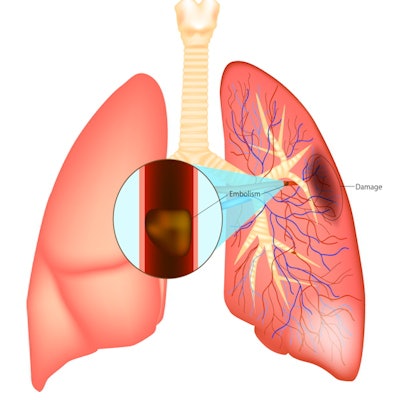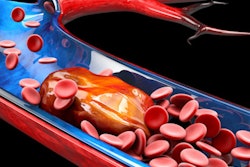
Diagnosing pulmonary embolism (PE) in the emergency department using D-dimer information shows promise as an alternative to diagnosing the condition via CT pulmonary angiography (CTPA), according to a study published December 7 in JAMA.
The findings suggest there's a way to decrease unnecessary imaging when it comes to diagnosing PE, wrote a team led by Dr. Yonathan Freund, PhD, of Sorbonne University in Paris, France.
"Various strategies have been derived to safely reduce the use of CTPA [for PE diagnosis]," the group noted. "In patients with a low subjective pretest probability of PE, the absence of all eight PE rule-out criteria (PERC) ... or use of an age-adjusted D-dimer cutoff ... safely excluded PE."
PE is typically diagnosed via CTPA if a patient's D-dimer levels are above a particular threshold, but some studies have estimated its diagnostic yield at only 10%. Researchers have tried to find ways of reducing the use of CTPA for diagnosing PE, and some studies have shown that the condition can be ruled out using the YEARS rule (an algorithm built on Wells score criteria that also incorporates information from varying D-dimer thresholds), Freund and colleagues wrote.
To explore whether a diagnostic strategy for PE that combines the YEARS rule with pulmonary embolism rule-out criteria (PERC) and age-adjusted D-dimer thresholds could offer a safe alternative to CTPA, the group conducted a study that included 1,414 patients who presented to 18 emergency departments in France and Spain between October 2019 and June 2020 with PE symptoms. The patients were randomized into an intervention cohort (726) and a control cohort (688), and the two cohorts were defined as follows:
- Intervention: PE excluded without chest imaging in patients with no YEARS criteria and a D-dimer level less than 1,000 ng/mL and in patients with one or more YEARS criteria and a D-dimer level less than the age-adjusted threshold.
- Control: PE excluded without chest imaging if the D-dimer level was less than the age-adjusted threshold.
The study's primary endpoint was venous thromboembolism (VTE) within three months of initial presentation in the emergency room. Secondary endpoints included ensuing chest imaging, length of stay in the emergency department, hospital admission, anticoagulation treatment, all-cause death, and all-cause readmission at three months after initial ED presentation.
Of the total patient cohort, 100 (7.1%) were diagnosed with PE in the emergency department; at three months postdiagnosis, VTE was identified in one patient in the intervention group and five patients in the control group. Of the secondary endpoints, only two showed statistical significance between the intervention and the control group: chest imaging (30.4% vs. 40%) and emergency department median length of stay (4 to 8 hours vs. 5 to 9 hours).
"[Our] strategy consisting of a combination of the YEARS rule with an age-adjusted D-dimer cutoff resulted in a noninferior proportion of VTEs at three months compared with a conventional strategy," Freund and colleagues wrote. "The intervention was associated with a statistically significant reduction in chest imaging use."
The study findings offer clinicians an effective alternative for working up patients presenting with PE symptoms -- with the understanding that some patients will require CTPA anyway, Dr. Marcel Levi of Maastricht University Medical Center+ in the Netherlands wrote in an accompanying editorial.
"[Much] effort has been devoted to [developing] triage protocols to identify the right patients who need CTPA to avoid unnecessary scanning, contrast-induced nephropathy, radiation exposure, cost, and overdiagnosis of small subsegmental clots, of which the clinical relevance is controversial. ... Taken together, there is a role for efficient diagnostic algorithms to decrease the use of CTPA in patients with clinically suspected pulmonary embolism," Levi wrote.





















